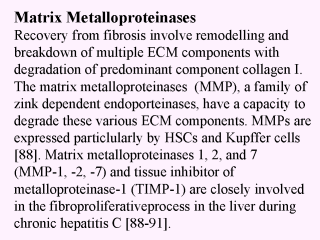 |
The imbalance between
matrix metalloproteinases and tissue inhibitors of matrix metalloproteinases (TIMPs) is
considered to be an important determination of ECM deposition and breakdown. Kasahara A et al. assessed the serum MMP-1, MMP-2,
TIMP-1 and TIMP-2 levels in 98 patients with chronic hepatitis C treated with interferon
beta to examine their clinical significance and determine whether they can be useful as
predictors of the interferon response [92]. Serum MMP-2 levels were significantly higher
in non-responders than in those with sustained and transient response (p<0.01 and
p<0.05, respectively), while serum MMP-1 levels among the three groups did not differ.
Compared with the levels in sustained responders, the total amounts of serum TIMP-1 were
significantly lower in transient responders and non-responders (p<0.01 and p<0.001,
respectively). As for serum TIMP-2 levels, a significant decrease was found in transient
responders and non-responders (p<0.01). The ratios of serum MMP-2 to TIMP-1 levels were
significantly higher in transient responders and non-responders than in sustained
responders (p<0.001, respectively). Thus, serum MMP-2 and TIMP-1 levels might be useful
for estimating the degree of liver fibrosis. The ratio of serum MMP-2 to TIMP-1 levels may
serve as a new predictor of interferon response in patients with chronic hepatitis C.
[92]. |
